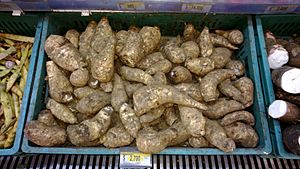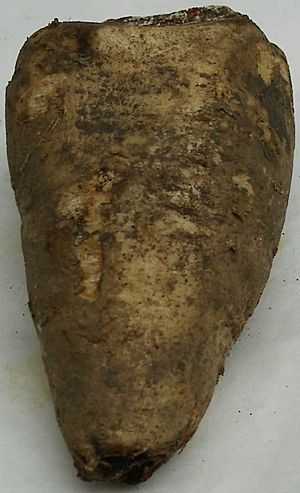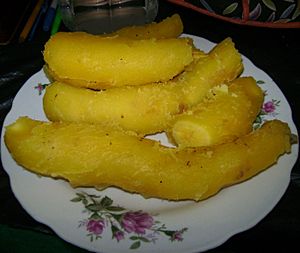Arracacha facts for kids
Quick facts for kids Arracacha |
|
|---|---|
 |
|
| Arracacha root for sale in a market | |
| Scientific classification | |
| Kingdom: | |
| (unranked): | |
| (unranked): | |
| (unranked): | |
| Order: | |
| Family: | |
| Genus: |
Arracacia
|
| Species: |
A. xanthorrhiza
|
| Binomial name | |
| Arracacia xanthorrhiza |
|
| Synonyms | |
|
|
Arracacha is a special root vegetable. Its scientific name is Arracacia xanthorrhiza. It comes from the Andes mountains in South America. People there love to eat its starchy root. It's a very important crop in many South American countries.
Contents
What is Arracacha Called?
Since arracacha grows in South America, most of its names are in Spanish or Portuguese. These are the two main languages spoken there.
The name "arracacha" comes from the Quechua word raqacha. People in the Andes region use this name. In Venezuela and Puerto Rico, it's called apio or apio criollo. This means "Creole celery". In Ecuador, it's "white carrot" (zanahoria blanca). And in Peru, it's sometimes called virraca.
In Brazil, arracacha has many Portuguese names. It's often called mandioquinha, meaning "little cassava". Another common name is batata-baroa, which means "baroness potato". Other names include batata-salsa ("parsley potato") or cenourinha-branca ("little white carrot"). In English, it's sometimes called "white carrot" or "yellow cassava". But these names can also refer to other vegetables.
Appearance and Types of Arracacha
The leaves of the arracacha plant look a lot like parsley. Their color can be dark green or even purple. The roots themselves are thick and short. They look a bit like fat carrots.
The skin of the root is usually off-white. But the inside can be white, yellow, or even purple.
How Arracacha is Grown
Arracacha originally grew in the western part of the Andes mountains. It can grow at many different heights. It thrives best between 1,800 and 2,500 meters (about 5,900 to 8,200 feet) above sea level. Farmers often grow arracacha with other crops. These include maize (corn), beans, and coffee.
This plant can get sick easily from viruses. It also takes a long time to grow, about 10 to 12 months. However, it doesn't need as much fertilizer as potatoes do. In the Southern Hemisphere, arracacha is harvested from January to September. It's important to pick the roots quickly. If they stay in the ground too long, they can become tough and woody.
Fresh arracacha roots don't last long. They need to be sold and eaten within a week of being harvested. You can keep fresh arracachas in the refrigerator for 2 to 3 weeks. Growing arracacha can be very profitable for farmers. It was brought to Brazil in the 1800s. Since the 1960s, it has been grown there for sale. Farmers in Brazil have even developed types that are ready to harvest in just seven months.
How to Eat Arracacha
The most common part of arracacha that people eat is its starchy root. You cannot eat it raw. But once it's cooked, it has a unique taste and smell. Some people say it tastes like a mix of celery, cabbage, and roasted chestnuts.
Cooked arracacha roots are used in many ways, just like boiled potatoes. You can serve them as a side dish. They can also be mashed into a smooth purée. People make them into dumplings or gnocchi. Arracacha is also used in pastries or made into creamy soups. These soups are often topped with chopped cilantro and croutons. Arracacha has a stronger flavor than potatoes. Depending on the type, its color can be brighter too.
In the Andes region, arracacha is made into fried chips and biscuits. It can also be ground into a coarse flour. The starch grains in arracacha are very small. This makes it easy to digest. Because of this, purées and soups made from arracacha are great food for babies and young children.
The young stems of the plant can be cooked or added to salads. The leaves can also be used as food for farm animals.
Arracacha Nutrition Facts
Arracacha is a healthy food choice. For every 100 grams (about 3.5 ounces) of arracacha, you get around 100 calories. Most of this comes from carbohydrates, about 23 grams. It has less than 1 gram of protein.
Arracacha is very rich in calcium. It has four times more calcium than potatoes!
Some types of arracacha have a yellow color. These types contain a lot of special colors called carotenoid pigments. These pigments help your body make vitamin A. If you eat a lot of yellow arracacha, your skin might turn a bit yellow. But don't worry, this is not harmful.
See also
 In Spanish: Arracacha para niños
In Spanish: Arracacha para niños



